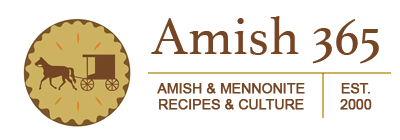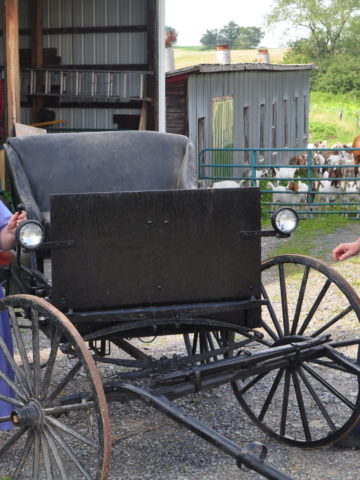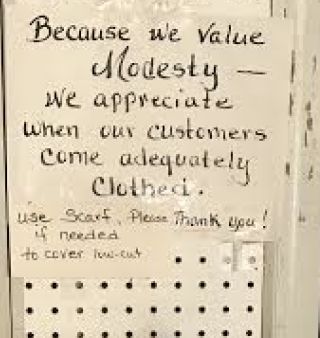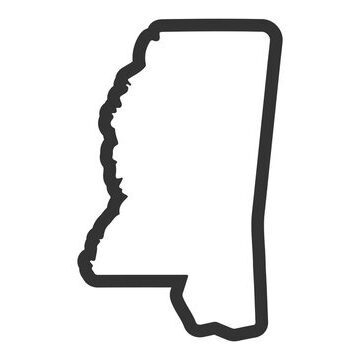A reader once asked me a question about why the Amish paint their doors blue? And it is true that if you drive through some Amish communities, you do see a lot of blue doors. Is there some deep meaning behind the practice?

🙋 FAQ Amish and Blue
Blue is a very popular clothing color among the Amish, perhaps second only to black and white. Blue is a calming color and not-flashy, which is in keeping with Amish traditions.
No, Amish buggies can be black, grey, brown, white, and even yellow in a handful of communities, but I've never seen blue buggies.
Besides white, blue seems to be the most popular interior color favored by the Amish. Again, think calming and tranquil!
🔵 Do the Amish Have The Blues?
Blue, as a whole, is a popular color in Amish culture. Personally, I love blue. It's a calming color and there would be something jarring about going into an Amish home with red walls, orange staircases, and pink doors. The blue spectrum is calm and in keeping with Amish traditions of tranquility.
In many Amish settlements the doors of a house are painted a blue hue. And if the door isn't blue, the inside walls are painted blue and pillows and blankets are blue. Calming.
The Conewango Valley of New York is a sprawling Amish settlement where, in fact, most Amish homes have blue doors (this definitely is not the case everywhere. I've been to plenty of Amish settlements where the doors are just plain white).

Like a lot of Amish customs, their genesis is often lost to history. I asked an Amish woman in the Conewango Valley about the blue doors. I was hoping to get a rich, granular answer that would solve this mystery.
But she just sort of shrugged and said "tradition."
And I believe that is likely the case. We "English" try to ascribe all sorts of meaning to Amish traditions: the curtains in an Amish home are tied a certain way it means they have a single daughter, celery on a wedding table symbolizes fertility, a blue door is a courting ritual. But a lot of these traditions are not imbued with meaning they are simply traditions and preference.
"Well, how do you get that exact same blue color for all the doors," I asked.
"We just take some to the hardware store and they do a color match," the woman said matter-of-factly.
📜 Enduring Traditions
Some sources say that in some communities, a door painted blue means a single daughter lives in the house. Others ascribe to the blue a meaning of holiness and purity. While others claim the he blue door is typically a shade of navy that's been chosen to represent the "blue sky" of heaven. Still, I have never once had an Amish person actually tell me a specific meaning behind a tradition so a lot of this is just speculation.
I've asked many Amish in many places about the significance of this or that tradition and am often met with the same shrug type answer. Made customs are just tradition and their original meaning, if they ever had any, have been lost to time.
Some Amish traditions may have had meaning originally, like I've heard a plausible reason explaining why the Amish of Berne, Indiana have open carriages, such that early on a covered carriage seemed very "aristocratic", but that meaning doesn't resonate with Amish today. So, yes, most of these quirky traditions are just that: traditions.
Sorry for the unexciting answer!





Nana
There may be a different answer to the blue paint as I learned when visiting in Louisiana and Texas. The natives tend to paint their porch ceilings blue and sometimes the door as well. The theory offered was that insects , especially wasps, thin it is sky and do not attempt to make wasp nests in the corners nor fly through the door. I have no idea if this works or is folklore.
I no longer get a newspaper and I do miss it. I not only read it thoroughly , especially the Sunday papers, but I used the paper for wrapping glassware against chipping., wrapping peelings for the garbage can, drop clothes for cleaning and painting, washing windows, packing boxes. I think people were more frugal years ago. Use it up and make do.
Kevin
Nana, very, very interesting about the blue door-wasp theory. See, that is exactly what I was talking about in that there may well have been a reason years ago for the start of the tradition, but the reason has been lost over the generations...
JamieV
In the South, we call that color Haint blue. It's a superstition about ghosts not crossing under an open sky or something.
That's why our porch ceilings are that color blue.
I wish the skeeters cared what color the roof was!
Kevin Williams
Very interesting, Jamie, thanks....if I want to ward off ghosts, I know what to do now!